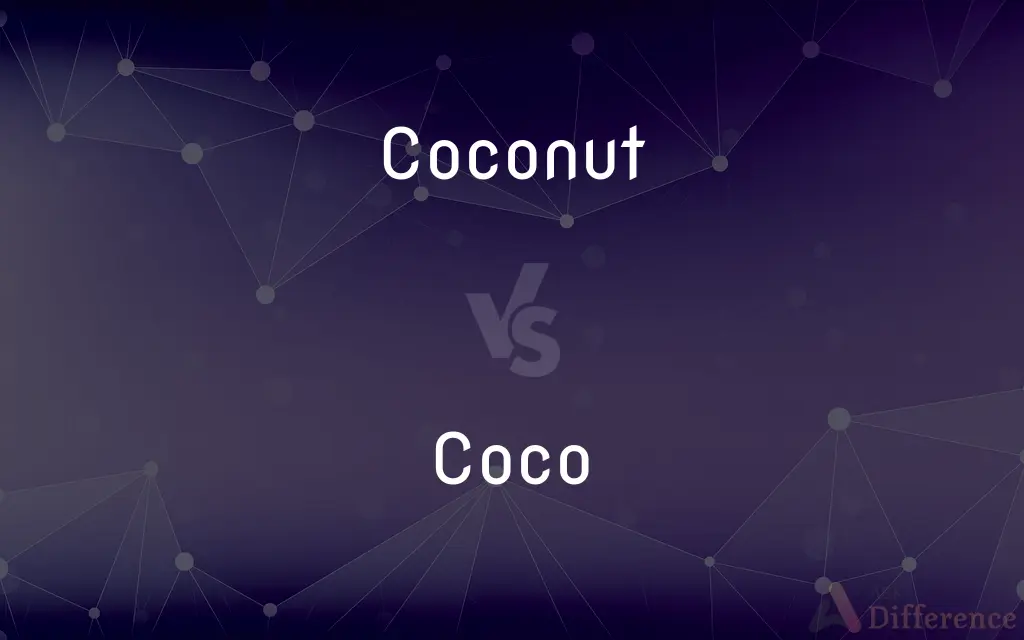Coconut vs. Coco — What's the Difference?
By Maham Liaqat & Urooj Arif — Updated on April 30, 2024
"Coconut" refers to the large, fibrous fruit of the coconut palm known for its edible properties and uses in products, while "Coco" is a term that can refer to various subjects including a popular animated film, or a shortened term for cocoa or coconut.

Difference Between Coconut and Coco
Table of Contents
ADVERTISEMENT
Key Differences
A coconut is the seed of the Cocos nucifera, a palm which is an essential crop in tropical areas, widely used for its water, milk, oil, and meat. Whereas, Coco can refer to different things; it could be shorthand for cocoa, used in reference to chocolate products, or it might be the title of a 2017 animated film by Pixar that explores the Mexican holiday Día de Muertos.
Coconuts are harvested from the coconut palm and have a hard shell, fibrous husk, and edible interior, known for its versatility in food products, cosmetics, and even industrial applications. On the other hand, cocoa (often shortened to coco) is derived from the seeds of the cocoa tree and is fundamental in the production of chocolate.
In terms of nutritional content, coconut provides high amounts of fat, fiber, vitamins, and minerals, making it beneficial in various diets and health products. Coco, when referring to cocoa, is rich in antioxidants and associated with numerous health benefits, including improved heart health and reduced inflammation.
The cultural significance of coconuts extends across various tropical cultures where it is not only a food staple but also used in religious ceremonies and traditional medicine. Coco, particularly the film, is significant for its cultural portrayal of Mexican traditions and has been praised for its representation of family values and cultural accuracy.
The environmental impact of growing coconuts has become a concern, with issues like deforestation and the exploitation of workers in producing countries. Conversely, cocoa production faces similar challenges, especially in terms of labor practices and the sustainability of farming methods.
ADVERTISEMENT
Comparison Chart
Definition
Fruit of the Cocos nucifera palm.
Can refer to cocoa or a cultural product like the film "Coco."
Uses
Food, cosmetics, industrial products.
Cocoa for chocolate, cultural narratives in film.
Nutritional Content
High in fat, fiber, vitamins, minerals.
Rich in antioxidants, beneficial for heart health.
Cultural Significance
Important in tropical regions for various traditional uses.
Cocoa as a staple in confectionery, "Coco" film celebrates Mexican culture.
Environmental Impact
Issues with deforestation, labor exploitation.
Challenges in sustainable farming, labor issues.
Compare with Definitions
Coconut
Associated with both health benefits and environmental concerns.
Coconut products are nutritious, though cultivation raises sustainability questions.
Coco
Used in beauty products, often as a hydrating component.
Her lotion contains coco butter for moisturizing.
Coconut
A key element in tropical landscapes and economies.
The local economy relies heavily on coconut farming.
Coco
Short for cocoa, used in making chocolate.
He added coco to his coffee for a chocolatey flavor.
Coconut
Culturally significant in rituals and traditional medicine.
Coconuts are used in religious ceremonies to bring prosperity.
Coco
Can also be a diminutive for "coconut" in product names.
Coco water is less fatty than coconut milk.
Coconut
Integral to tropical diets and various products.
Coconut oil is popular for cooking and skin care routines.
Coco
Impacts cultures through its roles in cuisine and media.
Coco has influenced both the chocolate industry and cultural representation in media.
Coconut
A large seed of the coconut palm, used for its water, milk, oil, and flesh.
She cracked open a coconut to drink its refreshing water.
Coco
Title of a 2017 Pixar film exploring Mexican traditions.
The movie Coco features the celebration of the Day of the Dead.
Coconut
The coconut tree (Cocos nucifera) is a member of the palm tree family (Arecaceae) and the only living species of the genus Cocos. The term "coconut" (or the archaic "cocoanut") can refer to the whole coconut palm, the seed, or the fruit, which botanically is a drupe, not a nut.
Coco
Coconut palm.
Coconut
The fruit of the coconut palm, consisting of a fibrous husk surrounding a large seed.
Coco
Coconut, the fruit of the coconut palm.
Coconut
The large, brown, hard-shelled seed of the coconut, containing white flesh surrounding a partially fluid-filled central cavity.
Coco
See Cocoa.
Coconut
The edible white flesh of the coconut, often shredded and used in food and confections or for the extraction of coconut oil.
Coco
Tall palm tree bearing coconuts as fruits; widely planted throughout the tropics
Coconut
A coconut palm.
Coconut
A fruit of the coconut palm (not a true nut), Cocos nucifera, having a fibrous husk surrounding a large seed.
Coconut
A hard-shelled seed of this fruit, having white flesh and a fluid-filled central cavity.
Coconut
(uncountable) The edible white flesh of this fruit.
Coconut
The coconut palm.
Coconut
A Hispanic or other dark-skinned person considered to have overly assimilated to white culture, a race traitor.
Coconut
A black person considered to have overly assimilated to white culture, a black race traitor.
Coconut
A Pacific islander.
Coconut
(slang) A female breast.
Coconut
(slang) The human head.
Coconut
The edible white meat of a coconut{3}; often shredded for use in e.g. cakes and curries.
Coconut
The cocoa palm.
Coconut
The large, hard-shelled oval nut of the cocoa palm. It has a fibrous husk containing a thick white fibrous meat much used as food, in confections, and in making oil. It has a central cavity filled (when fresh) with an agreeable milky liquid.
Coconut
The edible white meat a coconut; often shredded for use in e.g. cakes and curries
Coconut
Large hard-shelled oval nut with a fibrous husk containing thick white meat surrounding a central cavity filled (when fresh) with fluid or milk
Coconut
Tall palm tree bearing coconuts as fruits; widely planted throughout the tropics
Common Curiosities
What are the environmental impacts of coconut and cocoa cultivation?
Both coconut and cocoa cultivation involve environmental concerns including deforestation and the need for sustainable farming practices to protect ecosystems.
Can coco be used interchangeably with coconut in recipes?
Not typically; coco often refers to cocoa, which is used for chocolate products and differs significantly from coconut in flavor and texture.
How does the film "Coco" relate to cultural representation?
"Coco" is acclaimed for its respectful and vibrant portrayal of the Mexican tradition of Día de Muertos, highlighting family values and cultural heritage.
What health benefits are associated with coconut and cocoa?
Coconut is beneficial for its nutritional content including fats and minerals, while cocoa is valued for its antioxidants which support heart health and reduce inflammation.
What distinguishes the nutritional content of coconut from cocoa?
Coconut is high in fats and provides a substantial energy source, whereas cocoa is notable for its antioxidant properties and mood-enhancing effects.
What is the primary use of a coconut?
Coconuts are primarily used for their edible parts, including water, milk, oil, and meat, and in various industrial applications.
Are there ethical concerns associated with the production of coconut and cocoa products?
Yes, both industries face ethical concerns related to labor practices, with issues such as child labor and exploitation being reported in some regions.
Why might someone confuse coconut with coco?
The terms can be confusing due to "coco" sometimes being used as a shorthand for coconut-related products, although it is more commonly associated with cocoa.
How are coconuts culturally significant beyond food?
In tropical cultures, coconuts have uses ranging from religious ceremonies to traditional medicine, emphasizing their broad cultural importance.
How does the film "Coco" enhance understanding of Mexican culture?
Through its storytelling, character portrayal, and musical elements, "Coco" educates audiences about Mexican cultural practices, particularly the significance of Día de Muertos, fostering greater cultural appreciation and understanding.
Share Your Discovery

Previous Comparison
Throughflow vs. Throughfall
Next Comparison
Apocalypse vs. DystopiaAuthor Spotlight
Written by
Maham LiaqatCo-written by
Urooj ArifUrooj is a skilled content writer at Ask Difference, known for her exceptional ability to simplify complex topics into engaging and informative content. With a passion for research and a flair for clear, concise writing, she consistently delivers articles that resonate with our diverse audience.













































